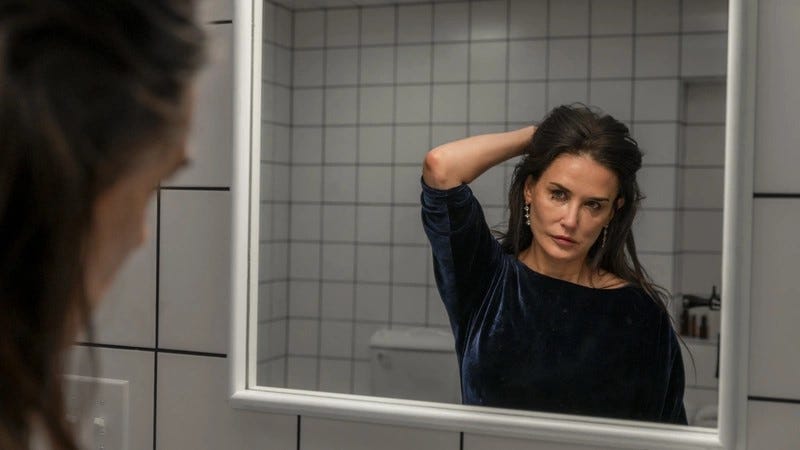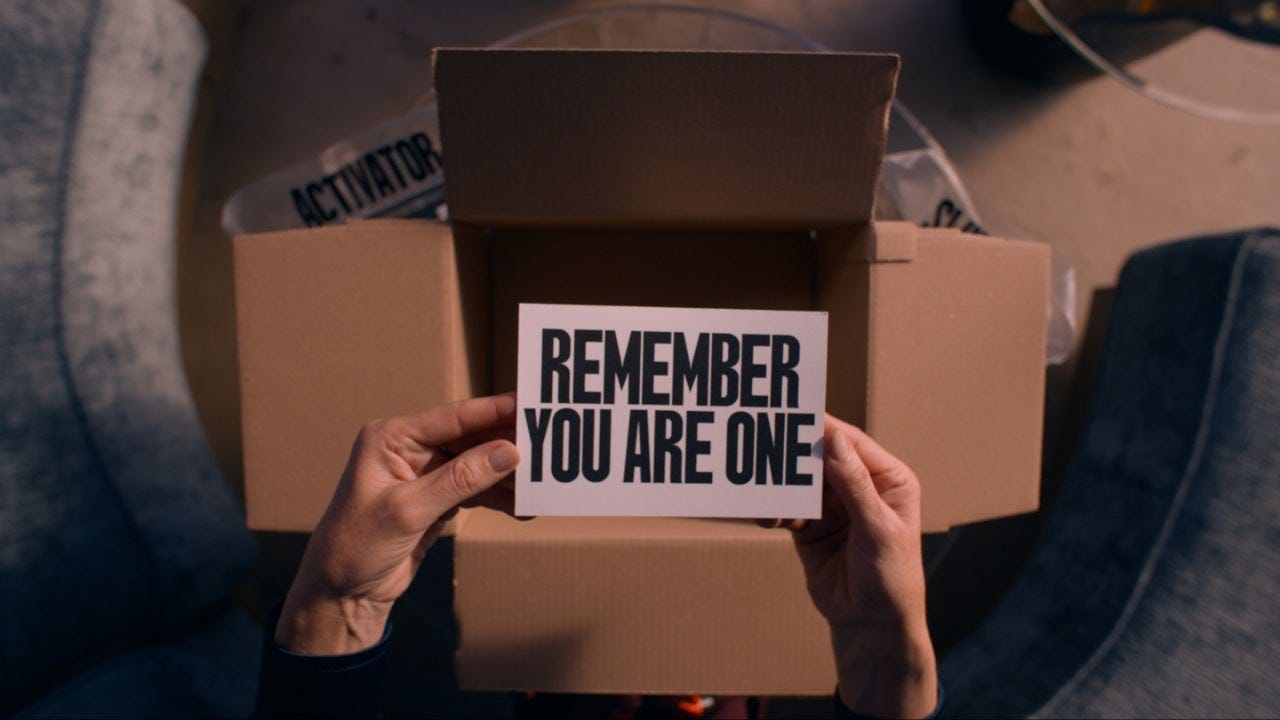The Substance Had Me Hooked from the Start
Then things got weird in this exquisite modern body horror
Hello, my friend. How are things? I have no doubt that you’ve crushed it this last week like the legend that you are. I’m still recovering from sickness, but it was nothing serious and I made the most of the time off work by reading and writing. I finally finished The Idiot, so I’m looking for somewhat of a palate cleanser. What do you have your nose in at the moment? Now, don’t be mad, but I’ve got another film review for you. It’s pretty leftfield though, so it might be worth your while.
I was lucky enough to catch an advanced screening of the latest arthouse horror film The Substance (2024) on Friday the 13th before it’s official release this Thursday. I hadn’t read too much about it and the trailer was pretty tight-lipped, so I went in without any expectations. All I knew was that it’s being marketed as a body horror (tick), it was directed by a French filmmaker (tick), and it’s over two hours long. This was enough to intrigue me and, boy, was I hooked. I don’t really know where to start. There is so much to unpack, from the style and narrative to the themes and commentary, but so little that I can say without giving it away. Perhaps this is what makes the striking trailer so alluring, which was an excellent decision in hindsight. Alas, I will do my best because I think that you should know about this film, even if it’s not in your wheelhouse. But be warned, it’s better accepted with an open mind.
The Substance was written and directed by Coralie Fargeat and premiered at the prestigious Cannes Film Festival in May this year before being distributed by Mubi. Demi Moore delivers a vehement performance as the fading reality TV star Elisabeth Sparkle, a fitness personality who has constructed her identity based on her looks. When viewers start dropping off, deplorable producer Harvey, played by a domineering Dennis Quaid, fires Elisabeth on her 50th birthday and sets out to replace her with a younger, more attractive woman in an attempt to boost ratings. Meanwhile, Elisabeth learns of a black market drug ominously called the Substance and undergoes an irreversible procedure that transforms her into ‘the best version of herself’. Her other body Sue, played by the seductive Margaret Qualley, joins Harvey in rebranding the show before the drug begins to have horrifying side effects.
A handsome young doctor gives Elisabeth a USB with “the Substance” and a phone number written on it that she dials to place an order. It could have been modernised with a QR code to a creepy website, but the strange video with deep synthesisers and a commanding voiceover works too. She then gets an envelope with a numbered card that she uses to access a dingy alleyway with a malfunctioning roller door that leads to a brightly lit room of postal boxes containing her starter kit. I love this stark contrast and how out of place Elisabeth looks in her long yellow coat with shiny black hair. Inside the package is the “activator”, a vial of bright green liquid resembling Herbert West’s serum in Re-Animator (1985), a needle for the “stabiliser”, which is sourced from the other body’s lower back via lumbar puncture, and a pinkish fluid for food, which must be administered through an IV line.
This is what I imagine it would be like if David Cronenberg made a Black Mirror episode. What do I mean by that? Well, once the customer – called the “matrix” – has activated the Substance, they must live in their “other self” for seven days to allow for the adequate secretion of stabiliser before switching back with a blood transfusion. No more, no less, or there will be consequences. This other self is then born from the back of the matrix, literally, with a grotesque scene of Sue sewing shut a gaping wound running down the length of Elisabeth’s spine. Of course, our protagonist can’t help themselves but take a little more (just this once!) when Elisabeth gets a taste of her new life as Sue, which has a see-saw effect on their bodies. The more you indulge in the Substance beyond the strict seven days as one version, the more it damages (and ages) the other, resulting in some graphic physical changes.
Obviously, there are some pretty heavy themes at play here. The biggest, as the title suggests, is substance abuse. Illicit drugs are unpredictable and too much can really fuck you up. Who knew? I find it particularly confounding that at no point throughout the film does Elisabeth (or Sue) try to find out what the Substance actually is, where it’s from, or who makes it. Another big one is ageism or, more broadly, body image. This fear of the cruel but inevitable passage of time is suggested early on, as characters in the studio wish Elisabeth a happy birthday, and is reiterated in the finale, which takes place on New Year’s Eve. My good friend and Dead House co-host Nathan defines body horror as an exploration of how much someone can change and still be considered human. I could be reading too much into it, but I wonder if there’s a commentary on the ethics of plastic surgery in casting Moore in the lead role.
It also exposes the unforgiving nature of show business, addressing the shelf life of those in front of the camera determined by the egos behind it. The vanity of Elisabeth’s motives, however, prove that she doesn’t always play the victim. She admires a billboard of herself opposite her living room window, after all. I loved the top-down shot of her star on the Hollywood Walk of Fame through the decades, weathered by the elements and treaded on by characters in dated fashion. There’s a duality in the almost fairytale narrative, navigating a beauty and the beast complex with forbidden temptation that leads to her downfall. Elisabeth becomes the evil witch and her dress at the New Year’s Eve launch resembles Cinderella’s gown. You could even recognise each of the seven deadly sins – pride, greed, lust, envy, gluttony, sloth, and, eventually, wrath – which corrupt character and impair judgement.
One of the things that makes The Substance hard to label is that it seems exploitative and provocative at the same time. With French director Fargeat understandably including lots of nudity and sexually-charged moments, it puts its glamorous cast members front and centre while using high and low angles to portray the male gaze. However, I appreciate that neither Elisabeth or Sue develop a connection to any real love interest, as Elisabeth bails on her date with an old classmate and Sue has a fling that doesn’t reach third base. On the other hand, it subverts the patriarchy by incorporating rich, old white men in powerful positions while the women do all the (oftentimes physical) work. It makes me question who the target audience is for this film. As a young man who isn’t completely satisfied with his appearance, it had me reevaluating shallow societal pressures, as well as my own, whether that was the point or not.
This film has a lot to say, yet it doesn’t spoon-feed it through dialogue. On that note, it kinda feels like it’s about 20 minutes too long, though that overtime could be taken from somewhere around the middle. There’s a lot of back and forth between the protagonist’s two lives, largely shown as Sue after she drains all the stabiliser from Elisabeth’s body and goes on a three-month bender. This leads to a horribly aged and deformed Elisabeth when they finally switch again, with arthritic joints, thin white hair and loose leathery skin. While it does use CGI in parts, the visceral makeup and practical effects are phenomenal. However, Moore’s natural voice doesn’t match the older look of Elisabeth, which felt too jarring, although this may have been intentional. Thankfully, there’s a totally unexpected final act with an abrupt tonal shift that takes the film in a completely different direction.
Sue begins literally falling apart in a scene that saw me go from squirming to laughing as it ventured into the absurd. I’m going to save the epic finale for dedicated viewers, but I will discuss the incredible technique of this film. The set design is clearly influenced by Suspiria (1977) and The Shining (1980), with bold carpet patterns and long corridors with bright red walls. I also spotted elements inspired by classic horrors like The Thing (1982), Poltergeist (1982), and even King Kong (1933). I loved the uncomfortable lingering close ups, particularly one of Harvey urinating while on the phone and eating an entire bowl of prawns. The sound design is just as prominent as the cinematography, with rich audio textures that could pass for ASMR and a distorted electronic score like that in the video on the USB. This is most noticeable in the end when things are splitting and squelching and spurting all over the place.
I didn’t know what I was walking into when I saw The Substance, but it turns out that that’s exactly what they want. It signals a promising future for emerging filmmaker Coralie Fargeat while standing out as the best work from Demi Moore and Dennis Quaid in years. A psychological analysis of social values, this film is as much of a horror as it is a dystopian mockumentary. Out Thursday 19th!





